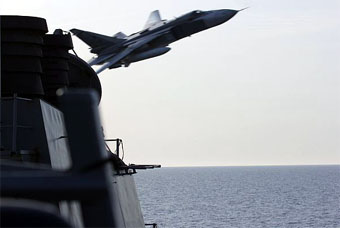
Photo by U.S. Navy/
Department of Defense
Russia Flexes Muscles With
Extreme Flybys
| published April 14, 2016 |
By Thursday Review staff writers
The Pentagon says it was arguably the most dangerous set of simulated attacks and close fly-bys that the U.S. Navy has encountered in a two year period in which there have been many close calls.
Between late Sunday and midday Wednesday, Russian helicopters and Russian fighter jets have flown perilously close to the USS Donald Cook, which the White House and the Pentagon say was on routine patrol in the Baltic Sea some 65 miles inside international waters, well outside of Russian waters.
Scores of close fly-bys have taken place this week, including flyovers by Russian helicopters which included photographers seen taking pictures of the deck of the USS Cook, an Arleigh Burke-class guided-missile destroyer deployed to Rota, Spain.
But it was those extremely close, high speed flyovers by Russian fighter jets—Sukhoi Su-24s—which drew the most attention of the crew of the Cook. On at least two occasions, jets engaged in “attack simulations” so close to the bow of the USS Cook that sailors and officers aboard estimate the distance between the lower fuselage of the planes and the deck of the Cook to have been less than 35 feet. The photo which accompanies this article, taken in the afternoon of April 12 by a sailor aboard the Cook, seems to confirm the estimates.
Such extreme low altitude attack gestures are considered dangerous from the standpoint of maritime custom and etiquette, and are considered provocative to military and international relations.
On Thursday, Russian media denounced the U.S. military’s “distressed reaction” response to the simulated attacks, which Moscow said was clearly only an exercise. The Sukhoi Su-24s were unarmed. But the Pentagon and several Navy spokespersons have said that the incident goes well beyond “pain and fear” and speaks to bullying on the high seas and to common sense when it comes to military matters and rules of engagement.
During his traditional once-per-year question and answer session with the Russian people on Thursday, President Vladimir Putin did not specifically address the issue of those practice runs by the fighter jets, but offered several responses in which her offered the position that Russia will be neither intimidated nor pushed around by other countries, and reminded his people that Russia always reserves the right to assert its power within areas Moscow considers within its sphere of influence.
Though the Navy and the Pentagon say the flyovers were dangerous and provocative, they also quietly point out that the jets—which had been identified by the officers of the USS Cook before the simulated attacks began—were clearly unarmed. The Navy also reports that the Cook had no reason to suspect that the planes intended to attack the ship, and their electronic equipment registered no detections of an intention lock and fire missiles or rockets.
Still, the commanding officer aboard the USS Donald Cook called the incident “unsafe and unprofessional.”
Related Thursday Review articles:
Russian Bomber Incident May Pose Challenge to NATO; R. Alan Clanton; Thursday Review; November 25, 2015.
U.S. Navy Settles on $159 Billion Budget for 2017; Keith H. Roberts; Thursday Review; February 11, 2016.
